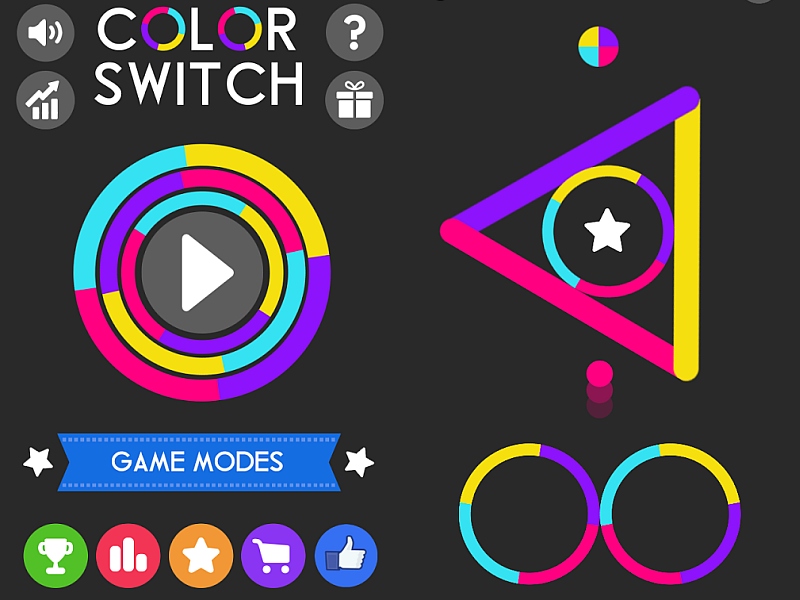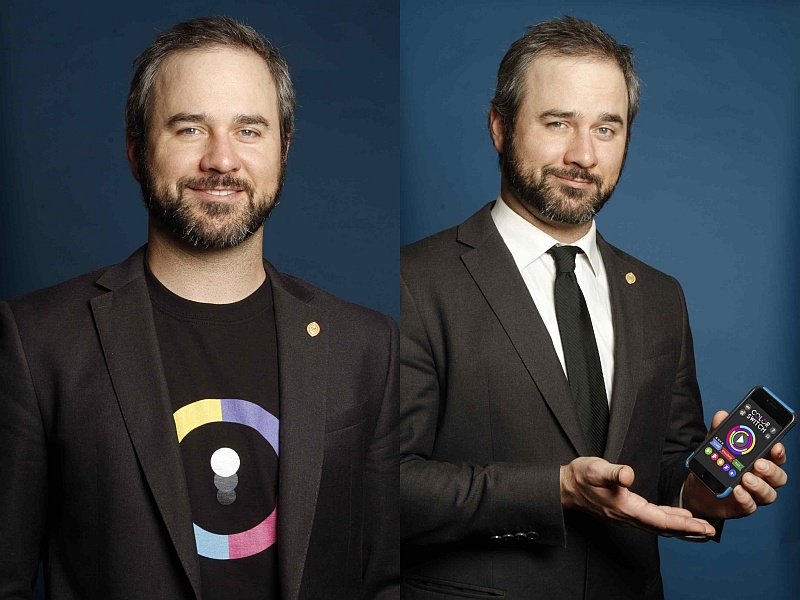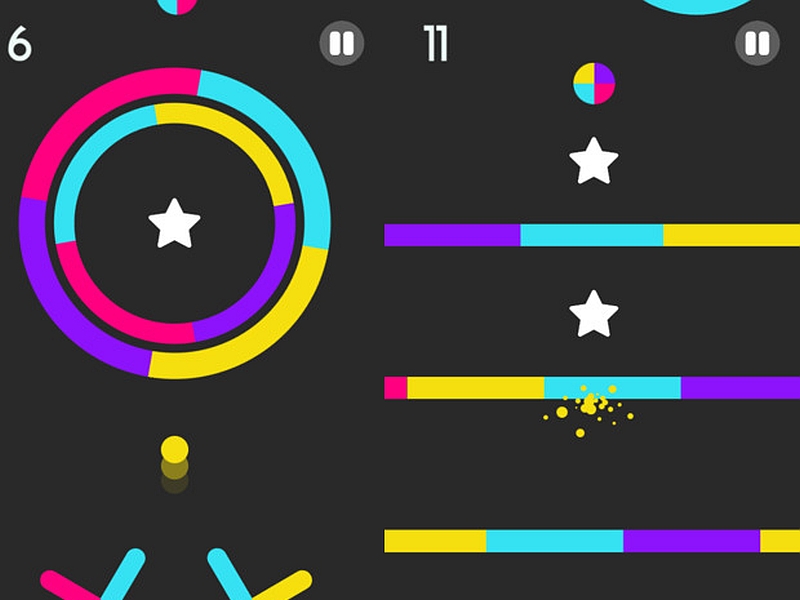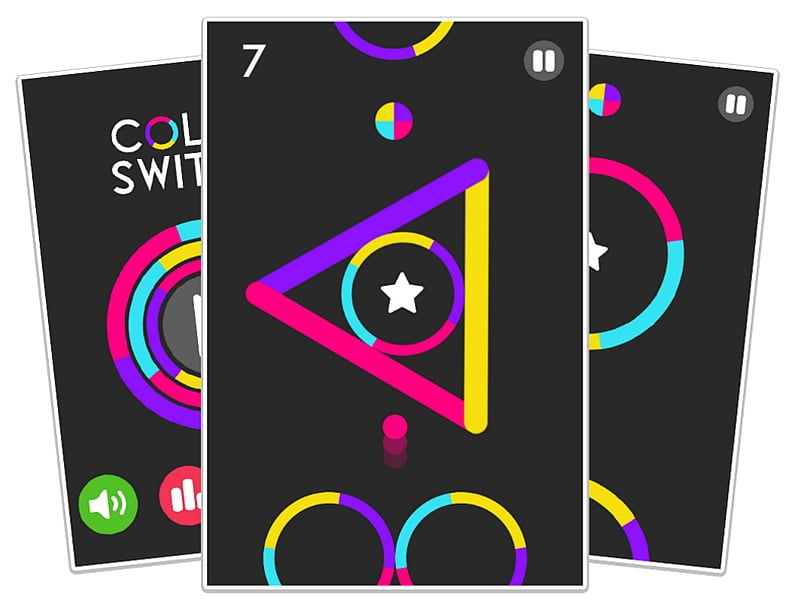
David Reichelt is a colourblind former Iraq War veteran, a medic who wanted to become a filmmaker. Instead, he’s become half of the team behind Color Switch, one of the most popular mobile games to release this year. The game has nearly 4,000 reviews on iTunes, and it’s been downloaded between 10 million and 50 million times on Google Play, with over 200,000 reviews.
“I wanted to be a film maker – I had around $8,000 (roughly Rs. 5.5 lakh) worth of film gear, and I sold all of it to finance the apps,” says Reichelt. “Otherwise, I did part time jobs (including cleaning pools and parking cars) to pay for myself. I lost $15,000 to $20,000 (roughly between Rs. 10 lakh and Rs. 13 lakh) along the way, but then Color Switch caught on, and there are now 50 million downloads.”
It was the number one app on the App Store for 27 days, edging out Flappy Bird’s 21 day streak, and it’s got one more thing in common with Flappy Bird – it’s a one-touch endless progression game, where you tap the screen to make your character bounce upwards, and progress through a series of obstacles, with excellent timing required to see you through. A small mistake and you’ll hit an object, which means it’s game over right away.
(Also see: Here are 800 Flappy Bird alternatives that are not simple clones)
The similarities end there though; unlike Flappy Bird, which “borrowed” its artwork and otherwise looked so terrible it was kind of endearing, Color Switch is slick. It’s sleek, with a great looking black and neon design, and pulsing music that hooks you into the game from the very start.
 Also, where Flappy Bird is a one trick pony that really wouldn’t have been memorable if it wasn’t for the insane difficulty level, Color Switch incorporates a number of design elements that elevate it and make it more than just another “Flappy” style game.
Also, where Flappy Bird is a one trick pony that really wouldn’t have been memorable if it wasn’t for the insane difficulty level, Color Switch incorporates a number of design elements that elevate it and make it more than just another “Flappy” style game.
Looking at Color Switch, it’s hard to believe that it’s been made by someone who is colour blind, since the colour changing mechanic is such an integral part of the game. Yet that’s perhaps why the game looks the way it does – the bold colours might even be considered garish, the flat black background too stark, but to Reichelt, it looked great. The result is something bold that stands out instead, though there were a few hiccups along the way. “I can see about 10 percent of the colours that other people can see, it’s hard to explain, but the game looks fine to me,” he says. “But for example, I thought I had picked blue for one of the colours, and I later realised that it’s actually purple.”
Reichelt says that he made 40 games before he hit pay dirt with Color Switch, but he happily admits that they were not very good. Once the idea for Color Switch hit him though, it was time to hit the drawing board, and figure out how exactly to make the game stand out.
“I would always observe the different games that I enjoyed playing, and I absorbed the ideas, and then I brainstormed 300 different ideas – literally with pen and paper – and Color Switch came out of that,” Reichelt says. The next step was to look at a number of different sources for inspiration, and then figure out how to make something unique and addictive.
 “I downloaded every game where you have to tap to progress upwards, and took them apart, to figure out their DNA,” says Reichelt. “What were the parts of these different games that were fun, that were rewarding as a user, and what were the parts that did not really work.”
“I downloaded every game where you have to tap to progress upwards, and took them apart, to figure out their DNA,” says Reichelt. “What were the parts of these different games that were fun, that were rewarding as a user, and what were the parts that did not really work.”
Inspiration could come from unlikely sources. “I was opening up my Gmail account one day, and you know how there is a round icon that flips through different colours when it’s loading?” he asks. “That gave me an idea about the look of things, and how the colour mechanic could work.”
The result of all these ideas was something that clearly draws inspiration from a number of different sources – from games such as Flappy Bird or Crossy Road, to the visual stylings of Tron – but has its own unique identity.
(Also see: A Game of Clones – Mobile Games Will Be Cloned and There’s Nothing You Can Do About It)
The way the game works is simple – you’re controlling a small ball that bounces upwards every time you tap on the screen, and drops back down otherwise. Ahead of you are a series of obstacles – spinning circles, pinwheels, pulsing orbs and fast moving bars, of four different colours: cyan, magenta, yellow, and purple. These near-neon colours stand out starkly against the plain black background, and the obstacles are segmented into these primary colours.
The gameplay mechanic is simple – there are stars, which are points, and there are discs, which change the colour of your ball. The ball can pass through obstacles that are the same colour, and if you come into contact with a different colour instead, you instantly smash into smithereens, with little blobs of every colour flying off in every direction.
It’s a simple game but one that’s really compelling, and it’s come a long way from his first game, says Reichelt. “My first game was called Baby 3 Horn’s Great Escape. It was about helping this baby dinosaur. We outsourced the programming for the game and that was a bad experience, the game didn’t feel right to us,” he says. “In the end, we decided that we need to be able to do this in-house.”
 After that, Reichelt says, there was a number of games made for the Nook. These were super basic games, he says, but over time the team was gaining experience and getting close to the point where it would be able to make Color Switch.
After that, Reichelt says, there was a number of games made for the Nook. These were super basic games, he says, but over time the team was gaining experience and getting close to the point where it would be able to make Color Switch.
When you start playing the game, it’s easy to understand it’s so popular. It’s visually upbeat, simple, and frustrating at the same time. It never feels like the game is cheating when you die, and you always think, just one more turn and I can do better. There are lots of small cosmetic features to unlock along the way, but the core gameplay never changes, and it’s perfectly suited for lots and lots of short attempts.
Dying is dramatic, and feels like a carnival. The colours are steady but the steady thumping beat of the music is unrelenting, and everything seems to pulse like a carnival. The colour mechanic adds a unique twist to what would otherwise be a very simple game, and the visual and audio design do a great job of keeping you addicted.
The music was first made by a DJ friend of one of the team members, Reichelt says. “I then cut the music from one of the tracks to suit the game, and it just fits,” he adds.
 The games multiple characters keep you interested, and it’s a free game that makes money through displaying ads. Because of this, Reichelt is invested in keeping people engaged with the game as much as possible, and so there have been a number of updates with new game modes such as Reverse and Race, and new characters to play as. There’s now an in-app purchase to remove ads as well, on Android right now, and with an update bringing this to iOS soon.
The games multiple characters keep you interested, and it’s a free game that makes money through displaying ads. Because of this, Reichelt is invested in keeping people engaged with the game as much as possible, and so there have been a number of updates with new game modes such as Reverse and Race, and new characters to play as. There’s now an in-app purchase to remove ads as well, on Android right now, and with an update bringing this to iOS soon.
This means that for Reichelt and the publisher, Fortafy Games, are in no hurry to try and create new games right away, and would rather focus on supporting Color Switch. “We haven’t talked about what’s next yet. We’re nearly at 50 million downloads, and hopefully we’ll hit 100 million this year, so there are lots of small updates we’re going to do that should keep people interested,” he says.
He’s not sure what comes next – but he tells us, “it’s funny, because I had to sell my film gear to fund the app, and now I’ve gotten a decent amount of money, and I’ve bought all my film equipment back.”
Download the Gadgets 360 app for Android and iOS to stay up to date with the latest tech news, product reviews, and exclusive deals on the popular mobiles.





